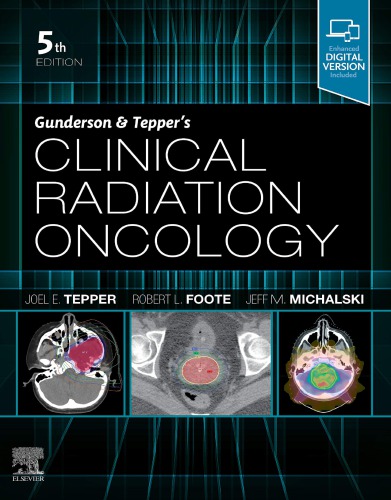Gunderson and Tepper’s Clinical Radiation Oncology 5th Edition by Joel Tepper 0323672481 9780323672481
$50.00 Original price was: $50.00.$25.00Current price is: $25.00.
Gunderson & Tepper’s Clinical Radiation Oncology 5th Edition by Joel Tepper – Ebook PDF Instant Download/DeliveryISBN: 0323672481, 9780323672481
Full download Gunderson & Tepper’s Clinical Radiation Oncology 5th Edition after payment.

Product details:
ISBN-10 : 0323672481
ISBN-13 : 9780323672481
Author : Joel Tepper
Gunderson & Tepper’s Clinical Radiation Oncology
Gunderson & Tepper’s Clinical Radiation Oncology 5th Table of contents:
Section I Scientific Foundations of Radiation Oncology
Part A Radiobiology
1 The Biological Basis of Radiation Oncology
What Is Radiation Biology?
Radiotherapy-Oriented Radiobiology: a Conceptual Framework
Radiation Biology and Therapy: the First 50 Years
The “Golden Age” of Radiation Biology and Therapy: the Second 50 Years
Clinical Radiobiology
Early and Late Effects in Normal Tissues
Radiation Biology in the 21st Century
References
2 Molecular and Cellular Biology
Molecular Basis of Cancer Development and Progression
Cellular and Molecular Basis of Radiation Damage
Biomarkers for Radiation Response Prediction and Personalized Oncology
References
3 Dose-Response Modifiers in Radiation Therapy
The Hypoxia Problem
Overcoming Tumor Hypoxia
Radiotherapy and Immunotherapy
Vascular Targeting Agents
Radiation Protectors
Summary
References
4 Interaction of Chemotherapy and Radiation
Historical Perspective
Rationale
Potential Biological Mechanisms of Drug Radiation Interaction
Analyzing Drug-Radiation Interaction
Step-by-Step Method for Constructing an Isobologram
Median Dose Effect Principle
Chemotherapy and Radiation and Combinations of Cytotoxic Agents
Chemoradiation Clinical Examples
Laboratory Investigations in Anal Cancer
Head and Neck Cancers
Non–Small Cell Lung Carcinoma
Cervical Cancer
Genitourinary Cancer
Glioblastoma
Future Directions
Summary
References
5 Biologics and Their Interactions With Radiation
Introduction
Cancer Cell Intrinsic Pathways
Tumor Microenvironment
Toxicity When Combining Radiation and Biologics
Future Directions
References
Part B Physics
6 Radiation Oncology Physics
Matter and Physical Definitions
Radiation Production and Treatment Machines
Interactions of Ionizing Radiation With Matter
Radiation Quantities and Measurement
Buildup Phenomenon
Dose Relationships for External Beams
Characteristics of Radiotherapy Photon Beams
Characteristics of Radiotherapy Electron Beams
Radiation Treatment Simulation
External Beam Treatment Planning and Dosimetry
External Beam Treatment Verification
External Beam Treatments: General Techniques
Three-Dimensional Conformal Radiotherapy
Imaging in Radiotherapy
Stereotactic Radiosurgery and Radiotherapy
Total-Body Procedures
Brachytherapy
Radiation Protection
Quality Assurance
References
7 Radiation Physics
History of Stereotactic Irradiation
Principles of Stereotactic Irradiation
Dosimetry of Radiosurgery Beams
Radiosurgery Commissioning and Quality Assurance
Conclusion
References
8 Radiation Physics: Charged Particle Therapy
Introduction
Charged Particle Interactions
Treatment Machines
Beam Characteristics
Dose Calculation
Optimization/Treatment planning
Quality Assurance
Particle-specific Clinical Considerations
Conclusions
Acknowledgments
Annotated Bibliography
Part C Related Cancer Disciplines
9 Surgical Principles
Preoperative Clinical Assessment
Perioperative Care of the Oncology Patient
Radiation Therapy and Wound Healing
Surgical Treatment of Breast Cancer
Multimodality Therapy for Pancreatic Adenocarcinoma
Multimodality Therapy For Adenocarcinoma Of The Rectum
Management of Retroperitoneal Soft-Tissue Sarcoma
Summary
References
10 Principles of Systemic Cancer Therapy
A Brief History of Chemotherapy
The Basis of Chemotherapy: Cancer Cell Biology
Models for Chemotherapy
Solid-Tumor Chemotherapy
Drug Interactions With Irradiation
Cytotoxic Drugs: Targeting DNA Synthesis, DNA Integrity, and Mitosis
Drugs That Induce Differentiation
Immunotherapy
Targeted Therapies: Signal Transduction Inhibitors
Receptor Tyrosine Kinases as Targets
HER2-Directed Therapy
PI3 Kinase as a Target for Cancer Therapy
Proteasome Inhibition
Angiogenesis Antagonists
Epigenetic Modifiers
Optimizing Clinical Chemotherapy: Pharmacokinetics and Pharmacodynamics
Clinical Schedules of Drug Administration
Using Genomics and Pharmacogenetics to Predict Tumor Response and Drug Toxicity
Drug Resistance
Combination Therapy
Summary
References
Bibliography
11 Imaging in Oncology
Imaging in Oncology
Computed Tomography
Magnetic Resonance Imaging
Ultrasound
Imaging Strategies
Chest Imaging
Imaging of the Gastrointestinal Tract
Imaging of the Abdomen
Imaging of the Pelvis
Imaging of the Brain
Imaging of the Head and Neck
Imaging of the Spine
References
12 Nuclear Medicine
Single-Photon Emission Tomography
Positron Emission Tomography
Basic Physics of Positron Emission Tomography
General Aspects of Tumor Visualization on FDG-PET
Patient Preparation for FDG-PET
PET Quantification
Common Indications for FDG-PET/CT in Oncology
FDG-PET/CT Applications in Other Malignancies
Summary
References
13 Tumor Ablation in Interventional Radiology
Ablative Techniques
Clinical Applications
Adjunctive Displacement, Monitoring, and Consolidative Techniques
Conclusion
References
14 Overview of Oncology Clinical Trial Design
Some Fundamental Concepts in Cancer Clinical Trials
Design Features by Developmental Phase
Phase II/III, Master Protocols, and Other Integrative Designs
Summary
Acknowledgment
References
15 Health Services Research in Radiation Oncology
What Is Health Services Research?
Studies of the Accessibility of Radiotherapy
Studying the Quality of Radiotherapy
Studying the Efficiency of Radiotherapy
Summary
References
16 Radiation Therapy in the Elderly
Incidence and Prevalence of Cancer in the Elderly
Biology of Aging
Comprehensive Geriatric Assessment
Examples of Radiation Management Changes for Specific Tumor Types in Older Adults
Future Directions
References
17 Palliative Radiation Medicine
Defining Terms: Palliative Care, Supportive Care, Radiation Medicine
Early Palliative Care: the Seminal Studies
The Radiation Oncologist’s Role in Palliative Care
Palliative Care Education for Radiation Oncologists
Dedicated Palliative Care Programs for the Radiation Oncologist
Palliative Radiotherapy at the End of Life and in the Hospice Setting
Palliative Radiotherapy Concepts
Conventional Radiotherapy for Bone Metastases
Spinal Cord Compression
Stereotactic Body Radiation Therapy for Bone Metastases
Oligometastatic Disease
Future Directions
References
18 Late Effects After Radiation
Introduction and General Considerations
Nervous System: Brain
Nervous System: Brainstem
Nervous System: Spinal Cord
Nervous System: Optic Nerves and Chiasm
Nervous System: Hearing
Salivary Glands
Larynx and Pharynx
Lung
Heart
Gastrointestinal System: Esophagus
Gastrointestinal System: Stomach and Small Bowel
Gastrointestinal System: Rectum
Gastrointestinal System: Liver
Genitourinary System: Kidney
Genitourinary System: Bladder
Genitourinary System: Penile Bulb
Conclusions
References
Section II Techniques and Modalities
19 Quality and Safety in Radiation Oncology
Introduction
Systems Engineering
Process Engineering and Radiation Medicine
Retrospective and Prospective Error Analysis
Incident Learning Systems
Quality Management
Future Directions
References
20 Brachytherapy
General Principles
Clinical Scenarios
Summary and Future Possibilities
Acknowledgments
References
21 Intensity-Modulated and Image-Guided Radiotherapy
Definitions for Conformal and Image-Guided Therapy
A Short History of Conformal and Image-Guided Therapy
Issues for Clinical Use
Planning for Conformal Therapy
Conformal Therapy Delivery
Clinical Considerations
Conclusion
References
22 Intraoperative Irradiation
History
Rationale
Biology of Intraoperative Radiotherapy
Local Control: an Important Endpoint
Local Control: Radiation Dose, Complications, Shrinking-Field Techniques, and Distant Metastases
Patient Selection and Evaluation
Sequencing and Dose of External Beam Radiotherapy and Intraoperative Radiotherapy
Intraoperative Radiotherapy Dose-Limiting Structures and Tolerance
Conclusions
Intraoperative Radiotherapy Results for Selected Disease Sites
Conclusions
Acknowledgments
References
23 Total Body Irradiation
History of Total Body Irradiation
Hematopoietic Stem Cell Transplant
Radiobiology
Immediate Toxicity and Management in Total Body Irradiation
Later Toxicity and Its Management in Total Body Irradiation
Physical Principles of Total Body Irradiation
Comparison of Techniques of Total Body Irradiation
Role of Total Body Irradiation in Contemporary HSCT
Dose of Total Body Irradiation
Fractionation and the Total Body Irradiation Dose Rate
Organ Shielding During Total Body Irradiation
Boosting in Total Body Irradiation
Total Body Irradiation in Nonmalignant Diseases
Total Marrow Irradiation: Systemic Targeted Radiotherapy Using IG-IMRT
Future Directions for Targeted TBI
Acknowledgments
References
24 Charged Particle Radiotherapy
Proton Beam Radiotherapy
Central Nervous System and Skull Base Malignancies
Head and Neck Malignancies
Thoracic Malignancies
Breast Cancer
Gastrointestinal Malignancies
Gynecologic Malignancies
Genitourinary Malignancies
Lymphoma
Sarcoma
Pediatric Malignancies
Metastatic Disease
Cost Effectiveness of Protons
Carbon Ion Radiotherapy
Neon Ion Radiotherapy
π-Meson Radiotherapy
Helium Radiotherapy
Conclusions
References
25 Targeted Radionuclide Therapy
Abbreviations
Tumor Targeting
Selection of Radionuclides
Radiobiology
Clinical Results
Toxicities Associated With TaRT and Methods to Ameliorate These Effects
Dosimetry
Future Considerations
Acknowledgments
References
26 Immunotherapy With Radiotherapy
Emergence of Immunotherapy
T-Cell Recognition of Tumors
Tumor Immune Escape
Radiation as an Immune Adjuvant
Radiation and Immune Checkpoint Inhibitors
Summary
References
27 Stereotactic Irradiation
Definition and Technical Principles of SRS
The Radiobiology of SRS
Clinical Outcomes
Conclusions
References
28 Stereotactic Body Irradiation
Safety Considerations and Technical Aspects of Stereotactic Body Radiotherapy
Clinical Radiobiology and Normal-Tissue Dose Constraints
Clinical Indications and Outcomes
Conclusions
References
29 Metastatic Disease
Bone Metastases
Spinal Cord Compression
Brain Metastases
Liver Metastases
Lung Metastases
References
Section III Disease Sites
Part A Central Nervous System Tumors
30 Overview
31 Low-Grade Gliomas
Introduction
Clinical Spectrum
Pathology
Surgical Management
Radiotherapy
Systemic Therapy
Prognosis and Future Directions
References
32 High-Grade Gliomas
Etiology and Epidemiology
Prevention and Early Detection
Pathology and Pathways of Spread
Biological Characteristics and Molecular Biology
Clinical Manifestations, Patient Evaluation, and Staging
Primary Therapy
Recurrent Disease
Irradiation Techniques and Toxicities
Treatment Algorithm, Controversies, Challenges, and Future Possibilities
References
33 Benign Brain Tumors
References
34 Pituitary Tumors and Craniopharyngiomas
Introduction
Etiology and Epidemiology
Biologic Characteristics and Molecular Biology
Anatomy, Pathways of Spread, and Pathology
Clinical Manifestations, Patient Evaluation, and Staging
Primary Therapy
Treatment Strategies for Specific Tumors
Irradiation Techniques and Tolerance
Craniopharyngioma
Conclusions
References
35 Spinal Cord Tumors
Epidemiology and Etiology
Prevention and Early Detection
Biological Characteristics and Molecular Biology
Anatomy, Pathology, and Pathways of Spread
Clinical Manifestations, Patient Evaluation, and Staging
Primary Therapy
Locally Advanced Disease and Palliation
Radiotherapy Techniques and Tolerance
Primary Therapy by Tumor Type
Treatment Algorithm, Challenges, and Future Possibilities
References
36 Ocular, Orbital, and Optic Nerve Tumors
Introduction
Etiology and Epidemiology
Optic Nerve Tumors
Benign Ocular Conditions
Biologic Characteristics/Molecular Biology
Pathology and Pathways of Spread
Clinical Manifestations/Patient Evaluation/Staging
Primary and Adjuvant Therapy
Locally Advanced Disease and Palliation
Techniques of Radiation Therapy
Intensity-Modulated Radiation Therapy
Proton Beam Therapy
Tolerance Issues
Conclusions and Future Possibilities
References
Part B Head and Neck Tumors
37 Overview
Molecular Biology and Ecogenetics
Receptor Tyrosine Kinases
Viral Causes—Epstein-Barr Virus
Viral Causes—Human Papillomavirus
Treatment of Relatively Locally Advanced Cancers
Biomarkers and Molecular Targeting
Prevention of Head and Neck Cancers
Summary
References
38 Oral Cavity
Etiology and Epidemiology
Prevention and Early Detection
Oral Care
Molecular Biology
Lip Cancer
Floor of the Mouth
Oral Tongue Cancers
Buccal Mucosa
Gingiva/Alveolar Ridge
Retromolar Trigone
Hard Palate
Conclusions and Future Possibilities
References
39 Oropharyngeal Cancer
Etiology and Epidemiology
Prevention and Early Detection
Biologic Characteristics and Molecular Biology
Pathology and Pathways of Spread
Clinical Manifestations, Patient Evaluation, and Staging
Primary Therapy
Locoregionally Advanced Disease and Palliation
Radiation Techniques and Tolerance
Treatment Algorithm, Challenges, and Future Possibilities
Conclusions
References
40 Nasopharyngeal Carcinoma
Etiology and Epidemiology
Prevention and Early Detection
Pathology
Anatomy and Pathways of Spread
Biological Characteristics and Molecular Biology
Clinical Manifestations, Patient Evaluation, and Staging
Primary Therapy
Locally Recurrent or Persistent Disease
Irradiation Techniques and Tolerance
Treatment Algorithm, Conclusions, and Future Possibilities
References
41 Larynx and Hypopharynx Cancer
Epidemiology and Etiology
Prevention and Early Detection
Pathology and Pathways of Spread
Molecular Biology
Clinical Manifestations, Patient Evaluation, and Staging
Primary Therapy
Locally Advanced Carcinomas
Irradiation Techniques and Tolerance
Treatment Algorithm, Controversies, Challenges, and Future Possibilities
References
42 Sinonasal Cancer
Etiology and Epidemiology
Prevention and Early Detection
Pathology, Biology, and Pathways of Spread
Clinical Manifestation, Patient Evaluation, and Staging
Primary Therapy
Locally Advanced Disease and Palliation
Irradiation Techniques and Tolerance
Diagnostic and Treatment Algorithm, Future Possibilities
Acknowledgments
References
43 Salivary Gland Malignancies
Etiology and Epidemiology
Prevention and Early Detection
Biologic Characteristics and Molecular Biology
Salivary Gland Genetic and Molecular Biology
Salivary Gland Tumor Microenvironment
Clinical Manifestations, Patient Evaluation, and Staging
Primary Therapy
Radiotherapy
Locally Advanced Disease and Palliation
Techniques of Irradiation
Treatment Algorithm, Conclusions, Controversies, and Future Possibilities
References
44 Thyroid Cancer
Etiology and Epidemiology
Prevention and Early Detection
Biologic Characteristics/Molecular Biology
Pathology and Pathways of Spread
Clinical Manifestations/Patient Evaluation/Staging
Papillary Thyroid Carcinoma
Follicular Thyroid Carcinoma and Hürthle Cell Carcinoma
Medullary Thyroid Carcinoma
Anaplastic Carcinoma
Primary Therapy
Thyroid Lymphoma and Anaplastic Thyroid Carcinoma
Irradiation Techniques and Tolerance
Treatment Algorithm, Conclusions, and Future Possibilities
References
45 Unknown Head and Neck Primary Site
Diagnostic Evaluation
Primary Therapy and Results
Treatment Techniques and Algorithm
Results
Complications
Conclusions
Acknowledgments
References
46 Management of the Neck
Anatomy of the Lymphatic System of the Neck
Imaging of the Neck
Staging of Neck Node Metastases
Incidence and Distribution of Neck Node Metastases
Recommendations for Selection of Target Volumes in the Neck
Neck Node Dissection Procedures and Sentinel Node Biopsy
Neck Node Delineation and Irradiation Techniques
Control of the N0 Neck
Control of the N1 to N3 Neck
Late Complications After Neck Treatment
Management of Recurrent Neck Disease
References
47 Cutaneous Carcinoma
Etiology and Epidemiology
Prevention
Clinical Manifestations, Pathobiology, and Pathways of Spread
Patient Evaluation and Staging
Primary Treatment and Results
Locally Advanced Disease and Palliation
Irradiation Techniques
Diagnostic and Treatment Algorithms
References
48 Malignant Melanoma
Etiology and Epidemiology
Prevention and Early Detection
Clinical Manifestations, Pathobiology, and Pathways of Spread
Patient Evaluation and Staging
Primary Therapy and Results
Locally Advanced Disease and Palliation
Radiotherapy Techniques
Treatment Algorithms and Clinical Trials
Acknowledgments
References
Part C Thoracic Neoplasms
49 Overview
Epidemiology
Biology
Staging and Workup
Normal-Tissue Toxicity Considerations
Treatment Considerations
References
50 Small Cell Lung Cancer
Introduction
Etiology and Epidemiology
Prevention and Early Detection
Biological Characteristics/Molecular Biology
Clinical Manifestations, Patient Evaluation, and Staging
Primary Therapy, Locally Advanced Disease, Combined-Modality Therapy
Treatment Algorithm(S), Controversies, Problems, Challenges, Future Possibilities, and Clinical Trials
References
51 Non–Small Cell Lung Cancer
Introduction
Etiology and Epidemiology
Early Detection and Prevention
Pathology and Molecular Biology of Lung Cancer
Carcinogenesis and Pathways of Spread
Clinical Manifestations, Patient Evaluation, and Staging
Primary Therapy
Radiotherapy Treatment Planning and Techniques
Systemic and Local Management of Metastatic Disease
Controversies
Conclusions
References
52 Uncommon Thoracic Tumors
Thymic Tumors
Pulmonary Carcinoid Tumors
Mesothelioma
Summary
Acknowledgments
References
Part D Gastrointestinal Tumors
53 Overview
Epidemiology and Prevention
Biology of Gastrointestinal Cancers
Anatomy and Pathways of Tumor Spread
Staging
Prognostic Factors and Patterns of Relapse
SEER Colon and Rectal Analyses
Single-Modality Versus Combined-Modality Treatment
Chemoradiation: New Chemotherapy Drugs
Irradiation Technique and Tolerance
Summary
References
54 Esophagus-Gastric Cancer
Introduction
Epidemiology and Etiology
Prevention and Early Detection
Biological Characteristics and Molecular Biology
Pathology and Pathways of Spread
Primary Therapy
Locally Advanced Disease and Palliation
Irradiation Techniques and Tolerances
Treatment Algorithm, Challenges, and Future Possibilities
References
55 Pancreatic Cancer
Introduction
Epidemiology and Etiology
Prevention and Early Detection
Biologic Characteristics and Molecular Biology
Pathology and Pathways of Spread
Clinical Manifestations, Patient Evaluation, and Staging
Primary Therapy
Locally Advanced Disease
Metastatic Disease and Palliation
Irradiation Techniques and Tolerance
Treatment Algorithm, Challenges, and Future Directions
References
56 Hepatobiliary Cancer
Introduction
Hepatocellular Carcinoma
Intrahepatic Cholangiocarcinoma
Gallbladder and Extrahepatic Cholangiocarcinoma
Hepatobiliary Cancer Irradiation Techniques and Tolerance
Hepatobiliary Cancer Treatment Algorithm and Future Directions
References
57 Colon Cancer
Introduction
Etiology and Epidemiology
Prevention and Early Detection
Biological Characteristics and Molecular Biology
Pathology and Pathways of Spread
Clinical Manifestation, Patient Evaluation, and Staging
Primary Therapy
Locally Advanced Disease, Metastatic Disease, and Palliation
Techniques of Irradiation
Treatment Algorithm, Conclusions, and Future Possibilities
References
58 Rectal Cancer
Etiology and Epidemiology
Prevention and Early Detection
Biological Characteristics and Molecular Biology
Pathology and Pathways of Spread
Clinical Manifestations, Patient Evaluation, and Staging
Posttreatment Assessment
Primary and Adjuvant Therapy for Resectable Disease
Locally Advanced Disease and Palliation
Irradiation Techniques and Tolerance
Conclusions
References
59 Anal Carcinoma
Introduction
Etiology and Epidemiology
Risk Factors
Prevention and Early Detection
Biologic Characteristics
Pathology and Pathways of Spread
Clinical Manifestations, Patient Evaluation, and Staging
Primary Therapy
Locally Advanced Disease and Palliation
Irradiation Techniques and Tolerance
Treatment Algorithm and Future Directions
References
Part E Genitourinary Tumors
60 Overview
Prostate Cancer
Bladder Cancer
Testicular Cancer
Kidney and Ureteral Cancers
Penile Cancer
References
61 Prostate Cancer
Epidemiology and Etiology
Prevention and Early Detection
Pathology and Pathways of Spread
Histology
Pathology of Prostate Cancer
Clinical and Pathologic Stage Grouping
Predictive Factors
Clinical Manifestations, Patient Evaluation, Staging
Primary Therapy
Surgical Therapy
Locally Advanced Disease
Adjuvant Versus Salvage Radiotherapy
Metastatic Disease
Irradiation Techniques
Treatment Algorithm and Future Directions
References
62 Bladder Cancer
Etiology and Epidemiology
Prevention and Early Detection
Biological Characteristics and Molecular Biology
Pathology and Pathways of Spread
Clinical Manifestations, Patient Evaluation, and Staging
Primary Therapy
Techniques of Irradiation
Treatment Algorithms
Future Possibilities
References
63 Testicular Cancer
Etiology and Epidemiology
Biologic Characteristics and Molecular Biology
Pathology and Pathways of Spread
Clinical Presentation, Patient Evaluation, and Staging
Primary Therapy
Nongerm Cell Testicular Tumors
Irradiation Techniques and Dose
Treatment Algorithms, Conclusions, and Future Possibilities
References
64 Kidney and Ureteral Carcinoma
Introduction
Etiology and Epidemiology
Prevention and Early Detection
Biologic Characteristics and Molecular Biology
Pathology and Pathways of Spread
Clinical Manifestations, Patient Evaluation, and Staging
Primary Therapy
Locally Advanced Disease and Palliation
Palliation and Metastatic Disease
Techniques of Irradiation
Treatment Algorithms, Controversies, Future Probabilities
References
65 Penile Cancer
Introduction and Anatomy
Etiology and Epidemiology
Prevention and Early Detection
Biological Characteristics and Molecular Biology
Pathology and Pathways of Spread
Clinical Manifestations, Patient Evaluation, and Staging
Primary Therapy
Locally Advanced Disease and Palliation
Irradiation Techniques and Tolerance
Treatment Algorithm, Controversies, and Challenges
References
Part F Gynecological Tumors
66 Overview
Cervical Cancer
Endometrial Cancer
Vulvar and Vaginal Cancer
Ovarian Cancer
References
67 Cervical Cancer
Epidemiology and Etiology
Prevention and Early Detection
Pathology and Pathways of Spread
Molecular Biology
Clinical Manifestations, Patient Evaluation, and Staging
Primary Therapy
Locally Advanced Disease and Palliation
Irradiation Techniques and Tolerance
Treatment Algorithm, Conclusions, and FUTURE Possibilities
References
68 Endometrial Cancer
Epidemiology and Etiology
Prevention and Early Detection
Biological Characteristics/Molecular Biology
Pathology and Pathways of Spread
Clinical Manifestations, Patient Evaluation, and Staging
Locally Advanced Disease and Palliation
Systemic Therapy for Recurrent or Metastatic Disease
Irradiation Techniques and Tolerance
Treatment Algorithm, Conclusions, and Challenges
References
69 Cancers of the Vulva and Vagina
Vulvar Cancer
Etiology and Epidemiology
Early Detection, Treatment and Prevention
Pathology and Pathways of Spread
Biology and Prognostic Factors
Clinical Manifestations, Patient Evaluation, and Staging
Primary Therapy
Locally Advanced Disease and Palliation
Irradiation Techniques and Tolerance
Challenges, Controversies, and Future Possibilities
Miscellaneous Vulvar Malignancies
Vaginal Cancer
Etiology and Epidemiology
Prevention and Early Detection
Pathology and Pathways of Spread
Clinical Manifestations, Patient Evaluation, and Staging
Primary Therapy
Locally Advanced Disease and Palliation
Irradiation Techniques and Tolerance
Treatment Algorithm and Future Possibilities
Nonsquamous Vaginal Malignancies
References
70 Ovarian Cancer
Introduction
Etiology and Epidemiology
Prevention and Early Detection
Biological Characteristics and Prognostic Factors
Pathology and Pathways of Spread
Clinical Manifestations, Patient Evaluation, and Staging
Primary Treatment of Ovarian Epithelial Cancer
Locally Advanced Disease and Palliation
Treatment of Nonepithelial Ovarian Tumors
Irradiation Techniques
Treatment Algorithms, Challenges, and Future Possibilities
Challenges and Future Possibilities
References
Part G Breast Cancer
71 Overview
Anatomy
Epidemiology
Etiology
Management of Ductal Carcinoma in situ
Staging
Breast Cancer Biological Characteristics
Treatment Overview
Special Issues in Breast Cancer
Final Remarks
References
72 Noninvasive Breast Cancer
Introduction
Lobular Carcinoma in Situ
Paget Disease
Ductal Carcinoma in Situ
References
73 Breast Cancer
Introduction
Pretreatment Evaluation
Surgical Techniques
Breast-Conserving Surgery With Radiotherapy
When to Use Nodal Irradiation
Treatment Techniques
Radiotherapy Dose and Schedule Parameters
Accelerated Partial-Breast Irradiation
Acute and Chronic Complications and Cosmetic Results
Patient Follow-Up
Treatment of Locoregional Failure
Conclusions
References
74 Locally Advanced and Inflammatory Breast Cancer
Introduction
Epidemiology
Biological Characteristics and Molecular Biology
Pathology and Pathways of Spread
Clinical Manifestations, Patient Evaluations, and Staging
Treatment Overview
Locoregional Treatment of Patients With Advanced Primary Disease
Inflammatory Breast Cancer
Techniques of Irradiation
Integration of Postmastectomy Radiation and Breast Reconstruction
Treatment Algorithms
Therapeutic Challenges and New Approaches
Conclusions
References
Part H Sarcoma and Benign Disease
75 Soft-Tissue Sarcoma
Etiology and Epidemiology
Prevention and Early Detection
Biologic Characteristics and Molecular Biology
Pathology and Pathways of Spread
Clinical Manifestations, Patient Evaluation, and Staging for Extremity STS
Primary Therapy for Extremity STS
Intraabdominal STS
STS of Uncommon Sites
Atypical-Behaving STS Subtypes
Salvage Treatment and Palliation
References
76 Benign Diseases
Definition and Classification of Benign Diseases
Radiobiological Aspects
Benign Disorders of the Head and Neck and Central Nervous System
Benign Disorders of the Eye and Orbit
Benign Diseases of Joints and Tendons
Benign Diseases of Connective Tissue and Skin
Benign Disorders of Bony Tissues
References
Part I Childhood Cancers
77 Overview
In Memoriam: Larry Emanual Kun
Cancer in Children
References
78 Central Nervous System Tumors in Children
Molecular Classification of Pediatric Brain Tumors
Childhood Central Nervous System (CNS) Tumors
Modern Pediatric Radiation Delivery
Embryonal Tumors
Atypical Teratoid Rhabdoid Tumor (AT/RT)
Embryonal Tumor With Multilayered Rosettes (ETMR)
Ependymoma
Low-Grade Astrocytoma
High-Grade Astrocytoma
Diffuse Pontine Glioma
Germ Cell Tumors
Craniopharyngioma
Choroid Plexus Tumors
Spinal Cord Tumors
Normal Tissue Tolerance and Side Effects
Acute and Subacute Toxicity
Neurocognitive Toxicity
Neuroendocrine Toxicity
Ototoxicity
Vascular Complications
Visual Outcomes
Radiation Necrosis and Pseudo-Progression
Leukoencephalopathy
Second Malignancy
Conclusions
References
79 Pediatric Soft-Tissue Sarcomas
Epidemiology
Biologic Characteristics and Pathology
Clinical Manifestations
Staging
Evaluation and Definition of Risk Classification
Primary Therapy
Radiation Therapy
Future Directions
References
80 Pediatric Sarcomas of Bone
Etiology and Epidemiology
Prevention and Early Detection
Biologic Characteristics and Molecular Biology
Pathology and Pathway of Spread
Clinical Manifestations, Patient Evaluation, and Staging
Treatment of Ewing Sarcoma
Treatment of Osteosarcoma
Future Possibilities and Challenges
References
81 Wilms Tumor
Introduction
Etiology and Epidemiology
Prevention and Early Detection
Biological Characteristics and Molecular Biology
Pathology and Pathways of Spread
Clinical Manifestations, Patient Evaluations, and Staging
Primary Therapy
Radiotherapy
Chemotherapy
Treatment Results
Irradiation Techniques
Other Studies
Retrieval Therapy
Late Effects
References
82 Retinoblastoma
Introduction
Etiology and Epidemiology
Prevention and Early Detection
Biologic Characteristics/Molecular Biology
Pathology and Pathways of Spread
Clinical Manifestations, Patient Evaluation, and Staging
Primary Therapy
Combined Modality
Locally Advanced Disease
Techniques of Irradiation
Long-term Effects of Treatment for Retinoblastoma
Additional Information on Etiology and Epidemiology
Additional Information on Locally Advanced Disease and Palliation
Additional Information on Late Effects of Radiotherapy
References
83 Neuroblastoma
Etiology and Epidemiology
Prevention and Early Detection
Biological Characteristics and Molecular Biology
Pathology and Pathways of Spread
Clinical Manifestations, Patient Evaluation, and Staging
Primary Therapy
Recurrent Disease and Palliation
Irradiation Techniques
Late Effects
References
84 Pediatric Leukemia and Lymphoma
Epidemiology
Etiology
Molecular Biology and Classification
Immunophenotyping
Cytogenetics
Presentation and Evaluation
Prognostic Factors
Treatment
Testicular Leukemia
Late Sequelae
Acute Myeloid Leukemia
Non-Hodgkin Lymphoma
References
85 Pediatric Hodgkin Lymphoma
Introduction
Etiology and Epidemiology
Pathology and Pathways of Spread
Staging, Clinical Manifestations, Patient Evaluation, and Prognostic Factors
Primary Therapy
Radiotherapy Considerations
Treatment of Relapsed and Refractory Disease
Treatment Algorithms
Summary
References
86 Rare Pediatric Tumors
Primary Liver Tumors of Childhood
Juvenile Nasopharyngeal Angiofibroma
Pleuropulmonary Blastoma
Hemangiomas and Lymphangiomas
Desmoplastic Small Round Cell Tumor
Langerhans Cell Histiocytosis
Nasopharyngeal Carcinoma
Pigmented Villonodular Synovitis (PVNS)
References
Part J Lymphoma and Hematological Malignancies
87 Overview
Basic Issues in Lymphoma
Pathological Classification
Molecular Basis of Lymphoid Malignancies
Staging
Treatment
References
88 Hodgkin Lymphoma
Introduction
Etiology and Epidemiology
Biological Characteristics/Molecular Biology
Pathology
Primary Therapy for Early-Stage Classical Hodgkin Lymphoma
Primary Treatment for Advanced-Stage Classical Hodgkin Lymphoma
Primary Treatment for Nodular Lymphocyte–Predominant Hodgkin Lymphoma
Refractory/Recurrent Disease
Techniques of Radiotherapy
Treatment Algorithm, Challenges, and Future Directions
References
89 Non-Hodgkin Lymphoma
Introduction
Etiology and Epidemiology
Prevention and Early Detection
Biological Characteristics and Pathology
Clinical Manifestations, Patient Evaluation, and Staging Classification
Prognostic Factors
Principles of Management
Management of Distinct Disease Entities
Conclusion
References
90 Multiple Myeloma and Other Plasma Cell Neoplasms
Introduction
Epidemiology and Etiology
Pathology and Molecular Genetics
Clinical Manifestations and Patient Evaluation
Therapy for Multiple Myeloma
Future Directions
References
91 Mycosis Fungoides
Etiology and Epidemiology
Biologic Characteristics and Molecular Biology
Pathology and Pathways of Spread
Clinical Manifestations
Variants of MF
Related Cutaneous T-Cell Lymphoproliferative Disorders
Prognosis and Staging
Patient Evaluation
Primary Therapy
Palliation
Techniques of Irradiation
Treatment Controversies, Problems, Challenges, and Future Possibilities
People also search for Gunderson & Tepper’s Clinical Radiation Oncology 5th:
gunderson and tepper’s clinical radiation oncology
gunderson and tepper’s clinical radiation oncology 6th edition
gunderson and tepper’s clinical radiation oncology 5th edition
gunderson and tepper’s clinical radiation oncology pdf
gunderson and tepper’s clinical radiation oncology
Tags: Gunderson, Tepper, Clinical Radiation, Oncology, Joel Tepper
You may also like…
Medicine - Oncology
Medicine - Oncology
Gunderson and Tepper’s Clinical Radiation Oncology 5th Edition
Medicine - Oncology
Uncategorized
Medicine
Fundamentals of radiation oncology : physical, biological, and clinical aspects 3rd Edition












